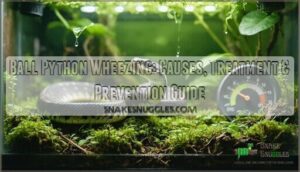This site is supported by our readers. We may earn a commission, at no cost to you, if you purchase through links.

You’ll notice audible breathing sounds, mouth breathing, or mucus around the nostrils.
Poor humidity levels, dirty substrate, or temperature fluctuations often trigger these infections.
Parasites and incomplete sheds can also cause breathing difficulties.
Don’t wait and see if it improves – respiratory issues worsen quickly in ball pythons.
A reptile veterinarian can prescribe antibiotics and provide proper treatment.
Meanwhile, check your enclosure’s humidity (55-60%) and temperatures (78-80°F cool side, 88-92°F warm side).
Proper husbandry prevents most respiratory problems, but knowing the warning signs makes all the difference.
Table Of Contents
- Key Takeaways
- How Do You Treat a Wheezing Snake?
- Why Does My Ball Python Make a Breathing Sound?
- Prevention of Respiratory Issues in Ball Pythons
- Frequently Asked Questions (FAQs)
- Why does my ball python wheezing?
- What does a ball python sound like with a respiratory infection?
- How do you treat a wheezing snake?
- What are the signs of upper respiratory infection in ball pythons?
- What does it mean if your ball python is wheezing?
- Why does my ball python make a breathing sound?
- How to tell if a ball python has a respiratory infection?
- Can stress cause wheezing in ball pythons?
- How does shedding impact a snake’s breathing?
- Are parasitic infections common in ball pythons?
- Conclusion
Key Takeaways
- Don’t wait if you hear wheezing – Your ball python’s wheezing signals a respiratory infection that will worsen quickly without immediate veterinary care and prescription antibiotics.
- Check your enclosure conditions immediately – Poor humidity (should be 55-60%) and wrong temperatures (78-80°F cool side, 88-92°F warm side) often trigger these respiratory infections.
- Watch for multiple warning signs – You’ll notice mouth breathing, mucus around nostrils, labored breathing, and lethargy alongside the wheezing sounds.
- Prevention beats treatment every time – Maintain proper humidity and temperature gradients, keep the enclosure clean, and schedule annual vet checkups to prevent most respiratory problems before they start.
How Do You Treat a Wheezing Snake?
When your ball python starts wheezing, you’ll need to act quickly since respiratory infections require immediate veterinary attention and prescription antibiotics.
You can’t treat this condition at home with over-the-counter remedies, so finding an experienced reptile veterinarian becomes your top priority for proper diagnosis and treatment.
Treatment for Respiratory Issues in Ball Pythons
Getting your wheezing ball python back to health requires professional veterinary care.
Your reptile vet will prescribe targeted snake wheezing treatment based on the specific infection type. A proper enclosure should allow the snake to stretch its full length.
Here’s your treatment roadmap:
- Antibiotic Options – Follow prescribed medication schedules for ball python antibiotics exactly as directed
- Supportive Care – Maintain ideal temperatures and humidity levels during recovery
- Nebulization Therapy – Use reptile-safe nebulizers if recommended by your vet
- Home Relief – Provide gentle steam baths to ease breathing difficulties
Finding a Reptile Veterinarian
Finding the right reptile veterinarian requires research beyond your local phone book.
Use the Association of Reptile and Amphibian Veterinarians (ARAV) website to locate qualified specialists in your area.
Look for these important vet qualifications:
- Experience treating respiratory infections in snakes
- Emergency care availability for after-hours situations
- Specialist referrals when advanced treatment becomes necessary.
Don’t let cost considerations delay snake veterinary care.
Consider researching reptile emergency supplies to be prepared.
Building rapport with a reptile vet before emergencies arise guarantees better veterinary care outcomes.
Why Does My Ball Python Make a Breathing Sound?
Your ball python’s breathing sounds typically indicate an underlying health issue that requires your attention and potentially veterinary care.
When your ball python starts making unusual breathing sounds, it’s time to pay attention—something’s not right.
The most common causes include respiratory infections from bacteria or viruses, parasitic infestations affecting the respiratory system, and incomplete sheds that block nasal passages.
Respiratory Infections
Respiratory troubles in your ball python often stem from infections that attack their delicate breathing system.
These ball python respiratory infections develop when harmful pathogens invade, causing mucus buildup and those concerning wheezing sounds you’re hearing.
Three main culprits behind snake respiratory disease include:
- Bacterial Infections – Common invaders that thrive in poor conditions
- Viral Infections – Including dangerous nidovirus impact on lung tissue
- Fungal Infections – Opportunistic organisms targeting weakened snakes
Python wheezing causes typically involve compromised immune systems from stress or inadequate husbandry, making your pet vulnerable to these reptile respiratory infections.
Some owners seek ball python antibiotics for treatment.
Parasite Problems
Beyond respiratory infections, snake parasites can turn your ball python’s breathing into a concerning wheeze.
Pentastomids (tongue worms) and lungworms directly invade respiratory passages, creating that telltale whistling sound during breathing.
Parasite Identification becomes your first line of defense.
Protozoan infections, nematode threats, and trematode impacts all contribute to respiratory distress.
These microscopic invaders don’t just affect breathing—they can spread between snakes and even pose risks to humans.
One potential issue to watch out for is the development of fluid-filled blisters on the ventral scales.
Your vet will likely recommend a fecal examination to pinpoint the exact culprit.
Treatment typically involves antiprotozoals for single-celled parasites or dewormers for larger worms.
Prevention Strategies include:
- Quarantining new snakes for at least 60 days
- Using frozen-thawed prey instead of live feeders
Regular health monitoring catches these sneaky parasites before they compromise your snake’s respiratory system.
Rough Sheds
When your ball python’s shedding goes sideways, wheezing can tag along for the ride. Incomplete sheds around the nose and mouth create breathing obstacles that sound like tiny whistles.
Here’s your game plan for managing shedding difficulty:
- Boost humidity levels to 60-70% during shedding cycles
- Check for stuck shed around nostrils and mouth areas
- Provide veterinary care if wheezing persists post-shed
Proper skin health prevents snake shedding issues before they become breathing problems. Maintaining proper humidity is key, and you can find humidity control products online.
Prevention of Respiratory Issues in Ball Pythons
Prevention serves as your first line of defense against snake respiratory issues in ball pythons. Maintaining proper humidity between 50-65% prevents respiratory tract irritation that leads to infections. Create a temperature gradient with your warm side at 88-92°F and cool side at 75-80°F to support your snake’s immune system.
Prevention beats treatment every time—proper humidity and temperature gradients keep your ball python’s lungs healthy and infection-free.
Keep your snake’s enclosure spotless through weekly substrate changes and monthly deep cleaning with reptile-safe disinfectants. This prevents harmful bacteria buildup that causes respiratory infections. Stress reduction plays a vital role—provide multiple hiding spots and limit handling during shedding periods.
Always quarantine new additions for 3-6 months before introducing them to your collection. This snake disease prevention strategy stops pathogens from spreading. Inadequate ventilation can also contribute to respiratory problems.
Here are three essential prevention steps:
- Monitor environmental conditions daily using digital thermometers and hygrometers
- Quarantine feeders for 48 hours before offering them to your python
- Schedule annual vet checkups to catch early signs of illness
Smart snake enclosure setup and consistent care prevent most respiratory problems before they start.
Frequently Asked Questions (FAQs)
Why does my ball python wheezing?
Like a clogged drain making gurgling sounds, your snake’s wheezing signals respiratory trouble.
You’re likely dealing with an infection, poor humidity levels, or temperature issues that need immediate veterinary attention and proper enclosure adjustments to address the respiratory issue.
What does a ball python sound like with a respiratory infection?
Your snake will make wheezing, gurgling, or whistling sounds when breathing. You’ll hear labored breathing, sometimes with a raspy quality. Open-mouth breathing often accompanies these respiratory sounds during infections.
How do you treat a wheezing snake?
You’ll need immediate veterinary care for antibiotic treatment. Meanwhile, increase your enclosure’s temperature to 88-92°F and humidity to 50-60%. Don’t attempt home remedies—respiratory infections require professional medication.
What are the signs of upper respiratory infection in ball pythons?
You’ll notice open-mouth breathing, wheezing sounds, mucus around the mouth or nose, nasal discharge, lethargy, loss of appetite, and labored breathing.
These symptoms require immediate veterinary attention for proper diagnosis and treatment.
What does it mean if your ball python is wheezing?
Your ball python’s wheezing typically signals a respiratory infection caused by bacteria, viruses, or fungi.
It can also indicate parasites, improper humidity, temperature issues, or stress.
Immediate veterinary care is essential for proper treatment.
Why does my ball python make a breathing sound?
Listen closely—that breathing sound you’re hearing isn’t normal chatter.
Your python’s respiratory system is sending distress signals, likely indicating infection, poor humidity, temperature issues, or blockages requiring immediate veterinary attention.
This situation demands urgent care, as indicated by the respiratory system sending these signals.
How to tell if a ball python has a respiratory infection?
Watch for open-mouth breathing, wheezing sounds, mucus around the mouth or nose, nasal discharge, lethargy, loss of appetite, and labored breathing.
These symptoms together indicate your snake needs immediate veterinary attention for labored breathing.
Can stress cause wheezing in ball pythons?
Yes, stress can definitely cause wheezing in your ball python. Environmental changes, improper handling, temperature fluctuations, and inadequate hiding spots trigger respiratory distress, making your snake breathe heavily and wheeze.
How does shedding impact a snake’s breathing?
Your snake’s breathing becomes labored during shedding when old skin blocks nasal passages.
Think of it like breathing through a stuffy nose – uncomfortable but temporary.
You’ll notice wheezing until the shed completes naturally.
Are parasitic infections common in ball pythons?
Parasitic infections aren’t extremely common in ball pythons, but they do occur. You’ll typically see them from wild-caught snakes, contaminated feeders, or poor husbandry. Captive-bred pythons have lower risk overall.
Conclusion
An ounce of prevention is worth a pound of cure in the case of ball python wheezing.
You’ve learned that respiratory infections cause most breathing problems, while proper humidity and temperature control prevent them.
Don’t hesitate to contact a reptile veterinarian if you notice wheezing sounds, mouth breathing, or nasal discharge.
Quick action saves lives and prevents complications.
Monitor your enclosure conditions daily, maintain clean substrate, and watch for early warning signs.
Your snake’s health depends on consistent, proper husbandry practices.
- https://www.askaivet.com/pet-health/why-is-my-ball-python-wheezing
- https://oddlycutepets.com/ball-python-wheezing/
- https://petshun.com/article/ball-python-wheezing
- https://www.terrariumquest.com/ball-python/respiratory-infection/
- https://reptifiles.com/ball-python-care-guide/ball-python-diseases-health/ball-python-respiratory-infection/









